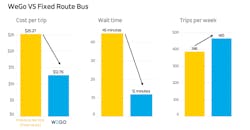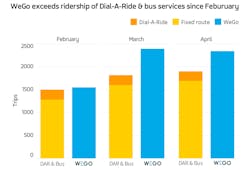Want more riders, better service and lower expense?
Bringing more riders to public transportation is never easy, especially since the onset of the pandemic. But many small towns like Gainesville, Ga., are surging ahead regardless. Within a few months, this community with less than 50,000 residents has increased adoption of public transit by providing more convenient, flexible services while cutting costs in half.
What is on-demand transit?
Hall County, Ga., like many rural areas in the United States, has faced a number of difficulties expanding access to public transit. These challenges have been particularly salient in two areas: The expanded urban zone, and a large rural region surrounding it.
Because of the scattershot geography of the communities and the resulting lack of rider density, the existing fixed route buses only captured about 15 percent of the county’s population.
And with the low number of buses on the road, headways were extremely long — from 30 to 60 minutes — meaning that it might take riders two to three times longer to complete a trip by bus than by driving their private vehicles. Facing an inconvenient fixed route service, many residents chose to drive, causing severe congestion. Frequent traffic jams were constantly putting buses off schedule, which of course made the fixed route service even less reliable.
For years, the county had been suffering from the criticism that the buses were not serving a sufficient number of people, especially transit-dependent residents, who either cannot drive or do not own vehicles. So, county leaders decided to take a step forward and try something new.
Say hello to WeGo.
In mid-August 2020, the county’s transit agency, Hall Area Transit, along with the city of Gainesville, partnered with Via to determine which areas covered by fixed route buses could be better served by microtransit.
In four months, Hall Area Transit launched WeGo, an on-demand microtransit service that replaced three underperforming fixed routes — with no operating cost increase. In fact, WeGo reduces cost per trip to half of its previous fixed-route service. This is because WeGo’s flexible scheduling only dispatches vehicles when there is a real-time demand — reducing the number of driver hours for the same number of trips, which better fulfills transit needs in low demand, low-density areas.
Via’s on-demand solution matches multiple riders headed in a similar direction into a smaller, single vehicle. The backend algorithm calculates the routing that allows for quick and efficient shared trips without long detours or ill-timed fixed route schedules, which improves the rider experience while lowering operating expenses.
An immediate success.
The service significantly expands access to more local destinations in the community for residents, covering areas the previous network didn’t reach. Within a month, Hall Area Transit decided to expand from the current five vehicles to 15 to better meet growing rider demand.
In July 2021 — six months after launch — WeGo expanded to the rest of Hall County, replacing Gainesville Connection, a fixed-route bus, and Dial-A-Ride, the county’s reservations-only curbside van service. The reason? As Phillippa Lewis Moss, director of Gainesville-Hall County Community Services, explains, “it became very apparent very quickly that WeGo has outpaced Gainesville Connection and Dial-A-Ride in all measurable ways.”
In one month since expansion, WeGo has made almost 5,200 trips, carrying more than 230 riders on average per weekday.
Many small town communities like Hall County are launching breakthrough services to their communities and seeing huge, almost immediate benefits. Pairing creativity with smart technology is a powerful way to build a transit system for the future.
-----
Alex Lavoie is the global head of operations at Via, a transit tech company.
About the Author

Alex Lavoie
Global Head of Operations, Via
Alex Lavoie is the global head of operations at Via, a transit tech company.



